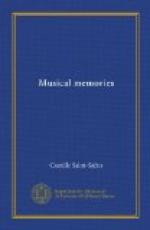Vacquerie approved highly the convent scene which Gallet invented. This introduced a quiet and peaceful note amidst the violence of the original work. Gallet wrote a sonnet in Alexandrine verse for Sabatino’s declaration of his love. I was unable to set this to music, for the twelve feet embarrassed me and prevented my getting into my stride. As I did not know what else to do, I took the sonnet and by main force reduced the verse to ten feet with a caesura at the fifth foot. I took this to my dear collaborator in fear and trembling, and, as I had feared, he at once fell into the depths of despair.
“That was the best thing in my work,” he said. “I nursed and caressed that sonnet, and now you have ruined it.”
In the face of this despair, I screwed up my courage. As I had previously cut down the verse, I now tried lengthening out the music. Then, I sang both versions to the disconsolate poet.
And what a miracle! He was altogether reconciled, approved both versions, and did not know which one to choose. We ended with a patchwork. The two quatrains are in verses of ten feet, and the two tiercets in Alexandrine metre.
Outside of our work, too, our relations were delightful. We wrote to each other constantly in both prose and verse; we bombarded each other with sonnets; his letters were sometimes ornamented with water colors, for he drew very well and one of his joys was to cover white paper with color. Gallet drew the sketches for the desert in Le Roi de Lahore and the cloister in Proserpine.
When Madame Adam founded the Nouvelle Revue she offered me the position of musical critic, which I did not think I ought to accept. She did not know where to turn. “Take Gallet,” I advised her. “He is an accomplished man of letters. He is not a musician in the sense that he has studied music, but he has the soul of a musician, which is worth much more.” Madame Adam followed my advice and found it good.
At this period, under the guise of Wagnerism, the wildest theories and the most extravagant assertions were current in musical criticism. Gallet was naturally well poised and independent and he did not do as the rest did. Instead he opposed them, but from unwillingness to give needless offense he displayed marked tact and discretion in his criticisms. This did him no good, however, for it aroused no sentiment of gratitude, and without giving him credit for a literary




